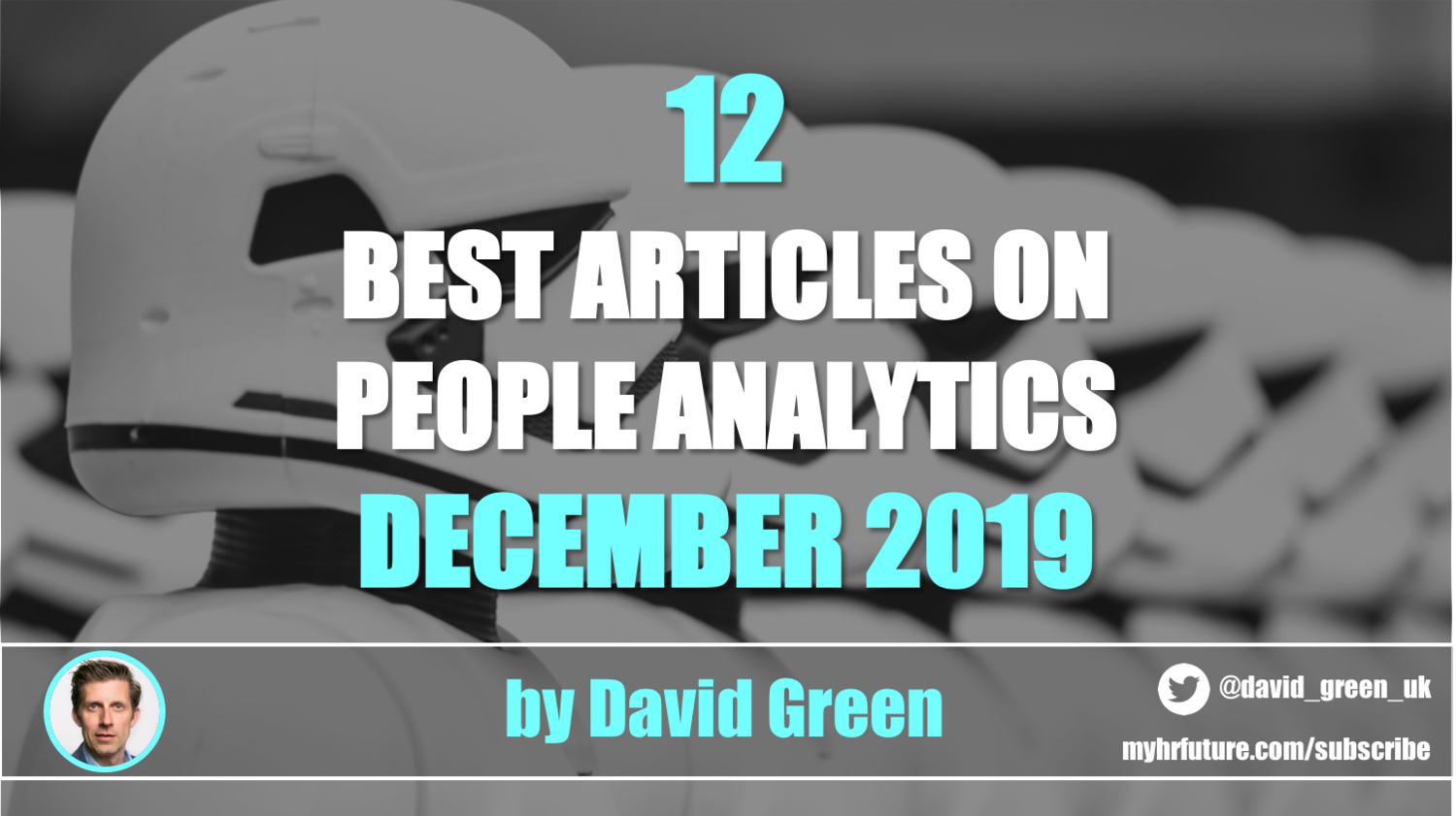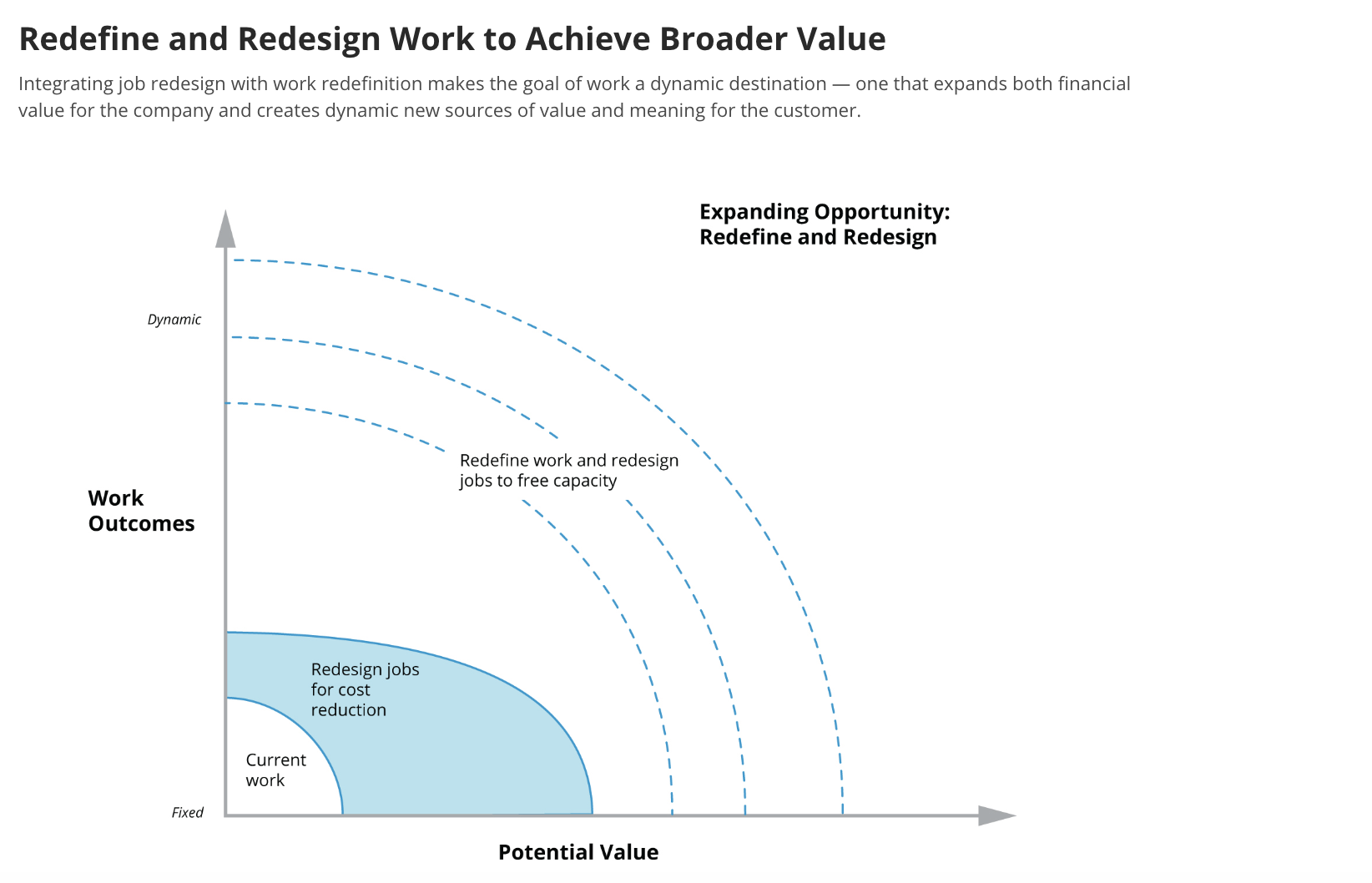The Best HR & People Analytics Articles of December 2019
Can 2019 nearly be over already? I know time flies as you get older but the speed this year has flown by has been ridiculous.
The eagle-eyed amongst you will have noticed that it’s not the end of December yet, but I wanted to publish ‘The best articles…’ before I go on my Christmas break.
It’s actually rather fortunate I did as a glut of seriously good content has been published in the first half of December. Indeed, the sheer depth of quality means that this collection might be the strongest monthly selection yet.
Certainly, there is plenty to read and absorb over the holiday period and much to inspire us to hit the ground running in 2020. There are two ‘Articles of the Month’ but in all honesty there could have been four or five, and Employee Experience, the Future of Work and Organisational Design all feature heavily.
I’ve also collected together a selection of 2020 predictions including my own Putting the ‘H’ back into HR. Together they show that whilst HR is undoubtedly being disrupted like never before, it is also one of the most exciting areas of the business in which to work.
I’d also like wish readers a Merry Christmas, Happy Holidays and all the best for a healthy and successful 2020. Thank you to everyone who has supported me, Insight222, myHRfuture and the Digital HR Leaders Podcast in 2019. It’s been quite a year!
Right on we go…
ARTICLES OF THE MONTH
TI PEOPLE, VOLKER JACOBS, MARK LEVY - On the Launchpad from Strategy to Execution – The State of Employee Experience 2019
Revealing new report from our friends at TI People on the State of Employee Experience in 2019. With extremely high adoption rates, large companies have massively embraced the idea of employee experience as a key driver of engagement and productivity, but only some have a consistent EX strategy, and even fewer are implementing it. Nevertheless, EX is pretty much the biggest thing in HR at the moment, it’s on the CEO agenda and as this report highlights the business case for EX is significant. What makes this particular report standout is that much of the focus is on the ‘how’ of EX through the design-share-measure-act methodology that is outlined and how to implement it in three stages (see FIG 1). Volker Jacobs and his team at TI People have been immersed in the EX space since 2016 and coupled with a Foreword by Mark Levy, who essentially created EX when he took the CX playbook and applied it to employees at Airbnb, this has created a critically important study.
FIG 1: The three stages of implementing Employee Experience (Source: TI People)
WORLD ECONOMIC FORUM, RAVIN JESUTHASAN, LEENA NAIR, NABIL DABAL, HARSHA JALIHAL, QUEENIE CHAN, DIANAH ALABDUL JABBER LYUBA SPAGNOLETTO - HR4.0: Shaping People Strategies in the Fourth Industrial Revolution
Wow! Another absolute must-read here. The paper, which is a collaboration between the WEF, Unilever, Saudi Aramco and Willis Towers Watson, is split into three sections. The first part explores why the Fourth Industrial Revolution has created the impetus to transform HR and people strategies. The second part outlines the six imperatives that form the basis for HR4.0: Developing new leadership capabilities, Managing the integration of technology in the workplace, Enhancing the Employee Experience, Building an agile and personalised learning culture, Establishing metrics for valuing human capital and Embedding diversity and inclusion (not much to disagree with here). Finally, the third part describes how 11 organisations are already responding to the need for change – including Unilever (see FIG 2), IBM, Haier and PwC.
Our success in the future of work will depend heavily on our ability to effectively prepare our workforce – by fostering a culture of reskilling, upskilling and lifelong learning
FIG 2: Unilever’s framework for the future of work (Source: Unilever)
CULTURE & ORGANISATIONAL NETWORK ANALYSIS
MATTHEW CORRITORE, AMIR GOLDBERG & SAMEER SRIVASTAVA - The New Analytics of Culture
Culture is easy to sense but hard to measure. The workhorses of culture research — employee surveys and questionnaires — are often unreliable. The authors of this HBR article, studied the language employees used in electronic communication (email, Slack and Glassdoor) to provide a fresh lens that challenges prevailing wisdom about organisational culture. The article outlines the methodology and key findings of three studies. The first assessed the degree of cultural fit between employees on the basis of similarity of linguistic style expressed in internal email messages. The second study analysed the content of Slack messages exchanged among members of nearly 120 software development teams to measure whether the impact on team performance. Finally, in the third study, the authors partnered with Glassdoor to analyse how employees talk about their organisations’ culture in anonymous reviews to examine the effects of cultural diversity on organisational efficiency and innovation. Another fascinating read.
Algorithms make estimates, but it is ultimately humans’ responsibility to make informed judgments using them
EMPLOYEE RETENTION
STEFANIE BECKER & MATTHIAS HEINZMANN - Showcase for a data-driven HR: Understand the business impact of employee attrition
I was fortunate to spend a day recently with SAP’s internal People Insights team at their HQ in Walldorf, Germany to learn how they are making HR more data-driven. This article by two of the People Insights team outlines the methodology (see FIG 3) that enabled them to identify the key drivers and reasons behind attrition in three pilot countries. The combination of driver and cost analysis also guided the team to provide evidence of the monetary business impact of people leaving the organisation.
FIG 3: The combination of Driver Analysis and Cost Analysis enables the business to identify better investment decisions to reduce attrition (Source: SAP People Insights team)
DATA DRIVEN HR
ALEXIS SAUSSINAN & SHWETA MODGIL - People analytics should be a part of company’s DNA
Alexis Saussinan is the Global Head of Strategic Workforce Planning and People Analytics at Merck Group, and is an accomplished leader of one of the more advanced functions I’ve come across over the past few years. As such, this interview in People Matters where Alexis shares his reflections on key trends and how organisations can leverage people analytics to drive true business value is a revealing read. Like Alexis, I’ll be speaking at the upcoming People Matters Tech HR, Singapore conference on 19-21 February.
People analytics can help position and support companies during their digital transformation in several ways
FUTURE OF WORK
VISIER | CHRISTY MARBLE, LEXY MARTIN - HR Trends 2020: The next decade of work
I’ve included a ‘special’ section later on 2020 predictions but wanted to call this fabulous resource out separately. Not content with restricting themselves to looking ahead to the next 12 months, Visier assembles a cast of customers, partners and their own experts to look at how HR is likely to evolve in the next decade. Ethics, AI, Employee Experience (see FIG 4), Reskilling and ONA all feature in what is an absolute must-read for anyone in our space. Guest contributors include Isabel Naidoo, Russell Klosk, Trent Cotton and Manish Goel.
FIG 4: Employee Experience takes over (Source: HR Trends 2020: The Next Decade of Work, Visier)
BCG: ORSOLVA KOVÁCS-ONDREJKOVIC, RAINER STRACK, PIERRE ANTEBI, ANA LÓPEZ GOBERNADO, ELIZABETH LYLE - Decoding Global Trends in Upskilling and Reskilling
Highlights from an enormous research study by BCG on how people are updating their skills in response to technological change and globalisation. Thanks to Andrew Marritt for bringing this study to my attention in his excellent Empirical HR newsletter, which as he commented is notable for those ‘close to the action’ being most concerned and therefore most proactive at learning. The section on how companies and individuals should adapt is an illuminating read.
Companies must understand how the megatrends affect their business so that they can help employees gain the skills they’ll need in the future
FIG 5: Perceived impact of megatrends vs. time spent learning (Source: BCG)
ETHICS
SENDHIL MULLAINATHAN - Biased Algorithms Are Easier to Fix Than Biased People
The author who is a Professor of Behavioural and Computational Science at the University of Chicago draws on two studies he co-authored to explain the difference between human and algorithmic bias and how the latter is significantly easier to fix. Both studies involved racial discrimination. The first study in 2004 revealed how hiring managers made biased decisions based on the name of applicants, whilst the second study from 2015 saw algorithmic decisions leading to inferior care for black patients. The conclusions drawn in the article provide some interesting parallels to the article by Tomas Chamorro Premuzic, Frida Polli and Ben Dattner featured in November’s collection.
Discrimination by algorithm can be more readily discovered and more easily fixed
DIVERSITY & INCLUSION
SÎAN WEBB - Four Steps to Use People Analytics to Understand the Gender Pay Gap
According to the World Economic Forum, on average women across the globe receive just 63% of their male counterpart’s wage, and this figure is even worse for BAME and other intersectional groups. Whilst this statistic is true in a broad sense, it is only through intelligent analytics, and building on your understanding of the true scale and specific drivers of workplace gender pay gaps, that it becomes a useful statistic. Throughout this article Sîan Webb explores the multiple layers that make up the gender pay gap.
Using data to understand how and what makes their employees tick can be essential in retaining your workforce and rethinking your remuneration model with diversity and equality in mind
ORGANISATIONAL DESIGN
JOHN HAGEL, JEFF SCHWARTZ & MAGGIE WOOLL - Redefining Work for New Value: The Next Opportunity
The premise of this research from MIT SMR and Deloitte is that redesigning jobs to take advantage of automation in order to boost efficiencies and reduce costs should not be seen as an end goal. Instead, it should be seen as part of a process that enables the larger opportunity of redefining work itself to create new value for customers and the business. The authors make the case that (as illustrated in FIG 6) companies won’t be able to significantly improve value creation if they redesign jobs to optimise processes with the goal of reducing costs. A powerful and persuasive read.
The future of work will require a new focus on the orchestration of cost and value as well as on redesigning jobs and redefining work
FIG 6: Redefine and Redesign Work to Achieve Broader Value (Source: MIT SMR/Deloitte)
EMPLOYEE EXPERIENCE
ELLIOTT NELSON & MARIA NEICU - Employee Experience 2020 Global Report & Case Studies
Hot on the heels of the superb EX research studies from TI People (see Article of the Month above) and Willis Towers Watson (featured last month) comes another excellent resource from Kennedy Fitch’s EX Leaders Network. Whereas the TI People study excels on the ‘how to’ of EX and like the Willis Towers Watson paper also provides evidence of the business case for EX, this report focuses on providing inspiration in how EX is being brought to life by several organisations. Features Case Studies from ABN AMRO (Frank van der Brink, Patrick Coolen, Sjoerd Kueter, Luuk Sombezki), Facebook (Tudor Havriliuc), ING (Sander de Bruijn), InVision (Marie Kretlow), KBC Group (Lucien De Boeck, Sandra Mertens), LinkedIn (Nawal Fakhoury, Shujaat Ahmad) and Walmart (Kristin Reilly).
FIG 7: EX requires a new way of working (Source: Kennedy Fitch EX Leaders Network)
2020 PREDICTIONS SPECIAL
DAVID GREEN - Putting the ‘H’ back into HR – 10 Predictions for HR in 2020 | TOM HAAK - 12 HR Trends for 2020 | DAVE ULRICH – Talent…Next? | VOLKER JACOBS - Employee Experience: What to expect in 2020 | ISABELLE ROUGHOL - 20 Big Ideas that will change your world in 2020 | DAVID MALLON, KATHI ENDERES, MATTHEW SHANNON, CHRIS HAVRILLA ET AL - Predictions for 2020: Clarity, Focus, Action!
It’s prediction season, so I thought it might be helpful to collect some of my favourite sages together and preface it with my own data-driven collection all themed around putting the ‘H’ back into HR (see FIG 8). Tom Haak delivers once again with an astute selection of trends for the year ahead whilst the ever-reliable Dave Ulrich envisions the next HR agenda and Volker Jacobs focuses his lens on what lies in store for EX in 2020. Isabelle Roughol’s 20 big ideas provide a much broader perspective than HR whilst David Mallon and the Bersin by Deloitte team have created a whole series of perspectives on three themes HR leaders will need in 2020: Clarity, Focus and Action.
PODCAST OF THE MONTH
RJ MILNOR & DAVID GREEN – Using ONA to identify drivers of high-performance in sales | LARS SCHMIDT - Recruiting Trends Of The Past Decade | LISA SCALES & MATT ALDER – Improving Social Mobility
A trio of podcasts to listen to over the holidays. First up, RJ Milnor explains how McKesson used Organisational Network Analysis to investigate the network behaviours of high-performing salespeople and managers (see FIG 9 below). Then Lars Schmidt looks back at some of the big recruiting trends of the past decade. Thank you to Culture Amp for including the Digital HR Leaders Podcast as one of its 11 best HR Podcasts to listen to in 2020. I’m not quite sure how Matt Alder’s consistently brilliant Recruiting Future was missed off this list, so to make up for that here’s a great recent episode with Lisa Scales on what employers should be doing to increase social mobility and how effective these efforts can be in terms of delivering tangible results.
FIG 9: How High-Performing Sales Teams Work - Top sales people build relationships differently (Source: RJ Milnor, presentation at UNLEASH America)
VIDEO OF THE MONTH
JONATHAN FERRAR - How to prioritise your People Analytics projects
In our work at Insight222, we have identified that world-class people analytics functions share seven key criteria of success. One of these is Prioritisation where world-class functions have well organised and defined criteria for the selection of advanced people analytics projects. In this video, Jonathan Ferrar shares his tips on how to prioritise your people analytics projects. This content comes from the myHRfuture Academy online training course called Creating the Right Methodology for People Analytics Projects.
SEE ME SPEAK AT PAFOW SAN FRANCISCO IN 2020
Join me and Al Adamsen for what promises to be the biggest PAFOW show yet in San Francisco from 29-31 January. More speakers will be announced soon but the likes of Dawn Klinghoffer, RJ Milnor, Heather Whiteman, Stacia Garr and Dafna Aaronson already confirmed. There are also PAFOW shows confirmed for Sydney (on 3-4 March) and London (29-30 April). Check out news on all the 2020 shows here where you can get a 15% discount on tickets with my code DG15. I’ll see you there.
BUILD YOUR DIGITAL HR SKILLS WITH myHRfuture's ONLINE TRAINING
Watch. Listen. Learn. Succeed. All in one collaborative space. The myHRfuture Academy provides you with an on-demand platform where you can get access to over 500+ pieces of bitesized learning content all expertly curated to help you build knowledge in the skills that you need to prepare for the future of HR. Get access to exclusive content on People Analytics, Digital HR & HR Technology, Design Thinking, Workforce Planning, Consulting & Influencing and Stakeholder Management. Whether you prefer to watch videos, listen to podcasts, read articles or complete an expert-led training course, myHRfuture has you covered.
ABOUT THE AUTHOR
David is a globally respected writer, speaker, conference chair, and executive consultant on people analytics, data-driven HR and the future of work. As an Executive Director at Insight222, he helps global organisations create more cultural and economic value through the wise and ethical use of people data and analytics. Prior to joining Insight222 and taking up a board advisor role at TrustSphere, David was the Global Director of People Analytics Solutions at IBM Watson Talent. As such, David has extensive experience in helping organisations embark upon and accelerate their people analytics journeys.
SEE ME SPEAK AT THESE EVENTS IN 2020
Now that my speaking gigs are over for 2019, it’s time to look forward to 2020. I’ll be chairing and/or speaking about people analytics, data-driven HR and the Nine Dimensions for Excellence in People Analytics model at the following events until the end of May 2020.
21-22 Jan - The People Analytics Program Peer Meeting (hosted by Lloyds Banking Group), London (for Insight222 clients only)
28 Jan - The People Analytics Program Peer Group Meeting, San Francisco (for Insight222 clients only)
29-31 Jan – PAFOW San Francisco
4 Feb - The People Analytics Program Peer Group Meeting, New York (for Insight222 clients only)
19-21 Feb – Tech HR, Singapore
16-17 Mar – HR Core Lab – Leading with Talent Analytics, Barcelona
24-25 Mar – UNLEASH Spring, London
27 Apr - Employee Experience Summit, Vienna
29-30 Apr – PAFOW London














